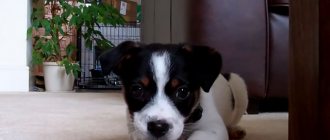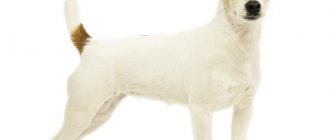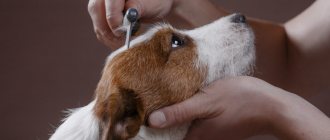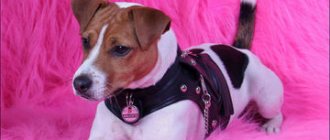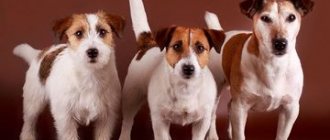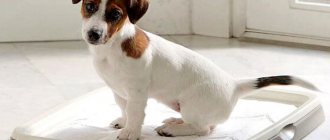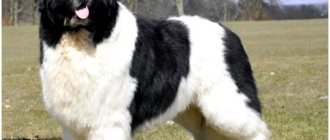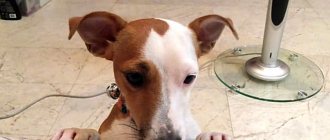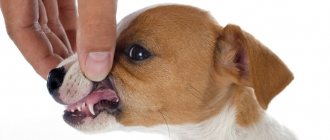Types of terriers by coat color
The breed was specially bred for hunting, especially small animals living in burrows. These rather small dogs can quickly climb into animal shelters and drive them out.
Pets of this species rarely have solid dark fur.
For your information! This species was named in honor of the ardent English hunter, part-time priest D. Russell, on whose farm terriers lived. The man himself never presented them at exhibitions or other similar events.
Regardless of the species, these pets are no more than 35-40 cm tall. They have a very strong muscular body and dark almond-shaped eyes. The nose lobe of all varieties is black, but the thick and smooth fur of purebred dogs does not have a particular variety of colors. The most characteristic thing about them is their white coat with spots of various red tones. However, modern science is developing more and more different hybrids of this variety.
Black
The black Jack Russell Terrier also exists among representatives of this breed. Many consider such fur to be a defect, and this is absolutely true, because the standard of the species is considered to be a color with a predominance of white wool. However, for true lovers of the breed this is not a problem, because plain dark fur looks very elegant and beautiful.
The dark color of terriers is not always continuous throughout the pet's body. The animal's paws may have a brownish-brownish tint, and there are small pale spots on the abdomen and chest.
Note! If you don’t want to deviate from the rules and buy a purebred puppy, you can buy an animal with small black spots.
Most sought after but very rare solid fur
White
White Jack Russell Terrier is a common occurrence for dogs of this species if the fur has additional spots of a different shade. However, there are colors that are completely white. These animals look very cute and friendly, which makes it hard to believe that this type of dog is intended for hunting.
There is ongoing debate that the solid white color of terriers may be a sign of disease in the animal. Moreover, many are sure that such fur indicates that the puppy is defective. However, if the edges of the pet’s lips and eyelids are black, we can say with confidence that this is a real purebred dog.
Black and white
Black and white animals of this species can be considered a standard if the main snow-white tone dominates in the color. Typically, such dogs have pale fur with black spots on the head, near the ear, around the eyes, at the base of the tail, and on the back near the base of the neck.
There is a non-standard dark shade of fur, which was mentioned above. When the pet has a predominantly rich black coat, and only small areas of white tint on the chest and abdomen.
Brown
In contrast to small areas of red color on the main background, brown is most pronounced in representatives of this breed. Sometimes the entire head with ears and the back of the animal can be painted in this tone. In this case, the shade of brown can be light in some areas and dark, even dark brown in others.
Note! Light brown fur is considered to be red in color.
Tricolor is a very rare occurrence.
Tricolor
The tri-color color is a very rare, uncharacteristic and non-standard occurrence for Jack Russells. Real purebred dogs intended for hunting, as a rule, do not have this color. The tricolor is considered a deviation from the standard, although such animals look very impressive and beautiful.
In tricolor dogs, white is the predominant tone; the second most common are, as a rule, various shades of red, even brown. The third color can be black or brown.
For your information! Sometimes the colors overlap each other and merge, which is also not typical for the colors of a purebred dog of this type of pet.
Ginger
Red color, as a rule, can be of different tones. The true color of the Jack Russell is considered to be a combination of red spots and the main snow-white coat. The spots are located predominantly on the upper parts of the body, rather than on the abdomen or chest. Shades of red range from light to dark, almost brown. In a purebred dog, the tones should not merge with each other.
History of the origin of the breed
In the past, the Cavalier King Charles Spaniel was very popular among the entire English nobility, from ruling figures to their courtiers. According to breed studies, it is a cross between a pug, a maltese and a miniature spitz.
The first mention of these four-legged aristocrats can be seen on canvases of the 16th century. Some paintings even include images of Queen Elizabeth I in the company of King Charles. According to some reports, a puppy of this breed was found in the folds of a dress after the execution of Mary Stuart.
The breed got its name thanks to the great love for these dogs of two, again, crowned heads: Charles (Charles) I and his son Charles (Charles) II. For my son, this love to some extent resembled a mania, thanks to which more than a hundred little cheerful dogs ran around the yard. When Charles the father died, his faithful dogs did not leave his bedside until the end. After this, the son decided to name the breed in honor of his father.
The appearance of the Cavalier King Charles Spaniel also has its own legend. It is associated with the battle for Blenheim and the Duchess of Marlborough, who nervously waited for news and tried to control herself, stroking the head of her beloved white and red dog. After this fight, five puppies were born, and all of them had a mark on their heads that resembled a fingerprint. This white diamond was later called the Blenheim spot.
When William IV became King of England in the 19th century, Cavalier King Charles Spaniels were subjected to harsh selection. The king liked more flat-faced dogs, which he ordered to be selected from all litters. And the familiar Cavalier King Charles spaniels with a normal muzzle were under threat of complete extinction.
But by a lucky coincidence, in the 20s of the 20th century, an ordinary American, Roswell Eldridge, wanted to buy the same cute dog that he had repeatedly seen in paintings with the English nobility, and went to England to get it. By that time, almost all dogs had flat faces.
Having learned that occasionally the puppies he needed were found in litters, he began to select them and began breeding just this species. And already in 1928, the King Charles Fanciers Club was created and the first breed standard for the Cavalier King Charles Spaniel was established.
Both types of dogs were called simply King Charles until 1945, and then the breeds were divided into simply Charles Kings and Cavalier King Charles Spaniels. And in the same year, the breed of such unusual spaniels was recognized by the English Kennel Club. And in 1955 it received recognition from the FCI.
Despite the fact that Cavalier King Charles Spaniels were bred in Great Britain, the breed is most widespread outside its homeland in the United States. And in England, short-nosed Charles Kings remained popular.
Genetics of colors
Despite a certain distinctive appearance, Jack Russell Terriers are quite distinct from each other within their group. Animal genetics plays a big role here. According to the type of structure, their coat can be:
- long and coarse, it is also called the long-haired and wire-haired variety;
- short and smooth, called short-haired and smooth-haired;
- Brocken - a specific type of coat between the wire-haired and smooth-haired types.
Regardless of the type of coat, all dogs of this species still belong to the same hunting breed of Russell Terriers, but they have different genetics of coat structure and color.
Note! All varieties of wool are quite dense in texture, which is due to genetics. To hunt and move quickly, you need reliable protection.
If we talk about the genetics of colors, then among the representatives of the breed it is almost impossible to find animals with multi-colored fur. This type of pet is not intended for beauty, but still in the modern world many acquire them for presentation at exhibitions. Therefore, there is a practice of breeding Jack Russells of tricolor colors.
The most dominant coat color is white. Genetics also plays here, because during hunting it is very important that owners do not shoot their pets instead of animals. The creator of these animals himself feared this, so the breed was bred on the basis of the white terrier. The remaining tones present on the dog's coat should not predominate. But these spots make the coloring more noticeable and characteristic. This may be why the red and white coat of the Jack Russell Terrier is the most recognizable of all other breeds.
Note! During a hunt, the fur coat of representatives of this type of dog quickly becomes dirty, which is dangerous for their life, because they can be accidentally shot. But here, too, genetics did not fail; thanks to its structure, dirt from smooth fur is cleaned by itself, and the fur again acquires its characteristic ideal appearance.
You can distinguish a mongrel from a purebred dog by the color of its coat.
Advantages and disadvantages
Advantages:
- Black Jack Russells are small and, due to their compact size, these dogs can live both in a country house and in an apartment.
- They will never refuse to run and play.
- Black Jack Russells are good with children.
- Extraordinarily loyal dogs: they try to accompany their owner everywhere.
- Known for their intelligence and intelligence.
- Caring for this dog is not difficult.
- If the pet is wire-haired or has a transitional coat, then it does not shed.
- The black Jack Russell's coat cleans itself.
Flaws:
- The hyperactivity of such a dog may not please all people.
- Left alone, he gets bored and because of this he may start chewing furniture or peeling off the wallpaper in the room.
- He digs up the soil in the flower beds, and at home he turns over flower pots and tries to make holes in the floor.
- The Black Jack Russell needs proper education and early socialization, without which it can grow up willful, disobedient and aggressive.
- Due to its natural hunting instinct, it can be hostile towards other animals.
- He knows how to cunning and manipulate his owners.
- If your pet is wire-haired or has a transitional coat type, it needs trimming.
Black Jack Russells are strong and resilient: they can do sports such as agility.
How to distinguish a mongrel from a Jack Russell terrier by coat color
In order not to have to distinguish a purebred dog from an ordinary mongrel, you must immediately purchase a puppy from a special nursery that has a good reputation. You can independently identify a real puppy by its fur, as well as its body structure.
To distinguish a real purebred dog from a mongrel by coat color, you need to pay attention to the following characteristic features of the dog:
- more than half of the color should be light in color;
- red, dark yellow and brown spots should be on the back, head, near the eyes, at the base of the tail;
- as a rule, the ears are also red or another dark shade;
- the edging of the eyelids and nose are only black;
- in addition to red, black spots are permissible, but they should not predominate on the main pale tone of the coat;
- The colors of the spots should not merge with each other.
Important! A true purebred Jack Russell should not be tall. It is most typical for this variety if the body, on the contrary, is elongated in length.
Russells are not very good with pets.
The main color of the Jack Russell Terrier is a white fur coat with spots of red or brown. However, other colors are available, the most unusual of which is solid black fur. Although the breed is a hunting breed, it is distinguished by its special friendliness and loyalty to its owner. Absolutely calm, intelligent animals get along well with children, but can quarrel with other pets. The acquired Russell puppy will become a loyal friend and protector for many years.
Source
Rules of care
Even when you are thinking about buying a Labrador puppy, you should take care of the place where your new pet will live. You should also be prepared for the fact that a brown Labrador will need to not only be combed, but also bathed.
Hygiene procedures directly affect the health of the dog.
It’s not limited to caring for the animal’s fur. You also need to take care of the ears, mouth (teeth) and claws of your brown Labrador.
The dog's ears should be clean and not spread an unpleasant odor around. They can be treated once a week with a cloth dampened with warm water or a special solution that can be purchased at pet stores.
The rag must first be wrung out well so that the liquid does not flow into the dog’s ear. For your animal's teeth, you can purchase a special brush and toothpaste, or you can contact a veterinarian.
Brown Labradors that walk a lot usually do not need to have their nails trimmed, but if your dog does need a “manicure”, then you need to trim the nails in a way that does not harm the dog - with a special nail clipper.
You should carefully monitor the condition of your eyes and nose.
You need to find a middle ground in the frequency of bathing - it is not recommended to bathe your dog often. Even specialized washing products can lead to skin irritation and dry epithelium.
You should bathe your pet in warm water using dog shampoo. Experts advise bathing your Labrador once a week.
As for walks, the Labrador needs to be accustomed to them from childhood. For a puppy, going outside should be kept short - the dog should not become hypothermic. Over time, the duration of the walk increases.
IMPORTANT!
You need to allocate at least two hours a day for walking; for training, you need to walk the dog for 3-4 hours once a week.
Experts advise feeding your Labrador without mixing natural food and industrial feed. A breeder or veterinarian will help you choose a diet specifically for your puppy.
If you choose natural food, it should be fresh and balanced. It is dangerous for your pet’s health to feed your Labrador with salty, sour, fatty, spicy or sweet foods.
If you feed your dog commercial food, it must be of high quality.
FCI standard
The country of origin of Jack Russell terriers is considered to be England, while the place of development is Australia. The artificially bred breed is primarily intended for burrow hunting, but its representatives are also excellent companions. The appearance standards established by the international canine organization (Federation Cynologique Internationale) are presented in the table:
| Body part | Body area | Body area element | Characteristic |
| Head | Skull area | Scull | Flat, of moderate width, tapering towards the jaws and eyes. |
| Stop (gap between muzzle and forehead) | Not very pronounced, but clearly visible. | ||
| Muzzle area | Eyes | Dark with a shrewd and kind expression. The eye shape is almond-shaped with the edges of the eyelids pigmented black. | |
| Nose | Black | ||
| Muzzle | The length from the nose to the stop should be slightly shorter than from the stop to the occipital protuberance. | ||
| Jaws/teeth | The jaws are very powerful, strong with a wide and deep structure. Well developed teeth have a scissor bite. | ||
| Lips | Pigmented black, tightly fitting. | ||
| Cheeks | With well developed chewing muscles. | ||
| Ears | Mobile with a developed structure. | ||
| Neck | Strong, robust, allowing the head to be balanced. | ||
| Body | Frame | Back | Level, the distance of the withers to the base of the tail is greater than the height from the withers to the tips of the fingers. |
| Breast | Not wide, but deep, clearly visible in front of the shoulder. The pronounced edge of the chest is located halfway between the withers and the pads of the paws. The ribs diverge from the ridge, tapering at the sides, with a volume of approximately 41–43 cm. | ||
| Small of the back | Short, muscular, strong. | ||
| Tail | When at rest it hangs down, and when moving it changes its position to a vertical one. If the tip of the tail is docked, then it must reach the same level as the fold line of the ears. | ||
| Limbs | Front | Shoulder-scapular girdle | The front part is not overloaded with muscles, the shoulder blades are well tilted back. |
| Shoulder | The angled design and shoulder length ensure that the elbows are positioned under the body. | ||
| Forearm | When looking at the animal from the side and front, the forearm appears straight from the elbows to the toes. | ||
| Front legs | Small round on hard pads, fingers moderately drawn together. | ||
| Rear | Knee | With a well formed angle. | |
| Hock joint | Understated | ||
| Metatarsus | Parallel in a free stance when viewed from behind. | ||
| Hind legs | Round, firm, on pads with small toes, moderately drawn together. The hind legs are muscular and strong, balanced in relation to the shoulders. |
The gait when moving dogs is free, correct, slightly springy. A flexible body and movements filled with expression make representatives of this species attractive and charming. The ideal weight of representatives of this breed corresponds to 1 kg for every 5 cm of height. This means that a Jack Russell, whose height at the withers is 30 cm, should weigh about 6 kilograms.
Coat
Terriers come in three types: smooth-haired, wire-haired or Broken. The latter variety is also called “with a break” - an intermediate option between smooth and hard wool. When breeding the breed, its purpose and lifestyle were taken into account. A tight-fitting, hard coat is provided for representatives of the species to facilitate penetration into the hole during hunting. The thick undercoat provides protection for dogs in adverse weather.
Color
The color of terriers is white with red and/or black spots or irregularly shaped markings, speckling is possible. Red color comes in all sorts of shades: from lemon to mahogany or chestnut. The tricolor, combining white, red and black, is a common occurrence among representatives of the species. The standard allows a snow-white color with black, yellow or red-brown spots. Albinism, the presence of merging marks, a light background occupying less than 50% of the dog’s body is considered a disadvantage.
Mating
Males and females are bred after a year. Before breeding a male dog, he must be taught the basic “rules of behavior”: the animal must obey the owner well and obey him unquestioningly. Otherwise, in the future the dog will “break loose” when he senses a female who is in heat. When a male dog is bred for the first time, the owner must help the animal into the correct position.
Bitches before estrus have very heavy bleeding, therefore, in order to avoid infectious diseases, the animal must wear special underpants, reminiscent of children's disposable diapers. They are purchased at veterinary pharmacies, and the size is selected depending on the height and weight of the bitch.
You can knit annually, on the second or third day of estrus. It is better to introduce the animals first to make sure that they do not show aggression towards each other. You can choose a pair from an advertisement in the newspaper or in a kennel club. It is desirable that the bitch and the dog have approximately the same appearance, age, and pedigree. Mating should take place in the dog's territory.
Parson aka long-legged
In the history of the formation of the breed, there was real confusion for a long time. It should be noted right away that there is no division of the Jack Russell Terrier breed into long-legged and short-legged.
So why do Russells have different length legs? The answer to this question lies in the fact that the long-legged terrier is a representative of a different breed called the Parson Russell Terrier.
According to the type of coat, the Parson Terrier can be smooth-haired or wire-haired, it always has a good undercoat. The division of the breed into two varieties, Jack and Parson, occurred in 2001. As a result:
- The Jack Russell Terrier has short legs and a strong build, reaching no more than 30 cm at the withers (FCI standard No. 345). The breed was popularized in Australia.
- The Parson Russell Terrier has tall legs and an elegant build; its height at the withers is no more than 36 cm (FCI standard No. 339). The breed was popularized in Great Britain.
The Parson Russell Terrier is faster at running; at one time it took part in horse hunting. It was this quality that made him a favorite of the kingdom of Great Britain, where from time immemorial horses and hunting were signs of aristocracy.
Funny and short-legged Jacks were not held in high esteem in their historical homeland and were practically driven into a corner as an unnecessary breed.
Whatever the appearance of the Russell Terrier, it owes its origin to the founder of the breed, Russell John, a clergyman and an ardent lover of hunting.
And if so, then all Russells are blood brothers and each of them contains the genes of the very dog from which they descended. It follows that they all have typical breed traits and descriptions:
- Character – lively, charismatic, inquisitive, agile, cheerful, loving. Hunting qualities are pronounced.
- Diseases that are inherited are hip dysplasia, congenital deafness, aseptic necrosis of the femoral head (Legg-Perthes disease) and an eye abnormality called “collie eyes” (improper development of areas of the eyes).
- Any Russell Terrier requires regular training, always with physical activity. Possessing increased jumping ability, this breed can perform intricate tricks and does not mind showing off its abilities in agility.
- Feeding Russells, regardless of coat type and leg length, must be of high quality, balanced and portioned, since they are all prone to obesity.
- Tail docking is not mandatory and does not affect the show career of Russell Terriers. As a rule, docking is carried out in early puppyhood to the length of the “grip handle”.
- In the cold season (at temperatures of -5C and below), Jack Russells and Parsons are dressed in clothes. Short-haired varieties of this breed are especially prone to colds.
- Caring for Russells is standard. Comb the coat and trim it if necessary. Take care of your eyes and ears. Vaccinate and treat for fleas and ticks.
- Puppies of this breed up to 3 months of age have practically no signs of future coat structure - this also applies to Jack Russells and Parsons.
- The price of puppies with documents depends on the pedigree of their parents, as well as their exhibition career. It varies from 30 to 80 thousand rubles. Without a pedigree, puppies are sold for 10-20 thousand rubles. Cheaper offers are either culls or crossbred puppies.
There is no point in making a comparison between the Jack and Parson Russell Terriers. They are similar in their bright temperament and tricolor color; they are distinguished only by the structure of their coat and the height at the withers.
Owners of the Russell Terrier breed are unanimous in their opinion that this dog is not suitable for everyone. She needs an active owner who can cope with the complex and restless nature of the hunting terrier. You can find reviews from those who call this breed too hyperdynamic and even extravagant.
Locus E (Extension)
The order of dominance is Em > Eg > E > Eh > e. According to the results of genetic studies, five genes are located in the E locus. The most dominant Em gene is the mask color, the eumeline mask on the dog’s face. The next most dominant gene is Eg - the “reverse” mask - a specific lightening on the face, known in two breeds: Afghan and Saluki (domino and grizzly colors). Gene E – normal distribution of eumelanin. The Eh gene is the sable color of English Cocker Spaniels. Gene e – recessive red color.
The DRT breed has only two genes of this locus - Em and E. The presumptive existence of a mask color in the breed, identified by existing external characteristics and the nature of their inheritance, still requires additional genetic examination, since the presence of Au-fawn color often gives characteristic blackening in various breeds on the face, which can often be confused with a mask color. The recessive red color E is not common in the breed, but individual individuals are found and, alas, more and more often...
At first glance, the recessive red ee is similar to the dominant Au-red, and it is not always possible to distinguish these two colors in an adult dog, although unlike the Au-red, the ee-red will never have the slightest admixture of eumelanin (black pigment). But since with Au-red in an adult the human eye cannot always see the individual few granules of black pigment in the coat, almost 100% results are obtained by examining puppies in the first weeks of life. Au-red puppies are always born with an admixture of black/brown hair (as if the puppies were dirty), and ei-red puppies are pure red from birth. Based on this distinctive feature and because the breed never produces red puppies from two tan individuals (At-At), although the result of the birth of tan individuals (At-At) from two Au-red individuals is quite expected, we can conclude that her-red color is fortunately it did not penetrate the breed.
This color is epistatic to all other colors, that is, the combination of its two genes in the genotype always gives a red color, regardless of which genes are located in other color-forming loci.
Recessive red color is found in the following breeds: English Setter, Irish Setter, Irish Terrier, Scottish Setter, Beagle, Dalmatian, Labrador, Golden Retriever, Labrador, Pointer, Poodle, English and American Cocker Spaniels, Russian Spaniel, Chow Chow, Field spaniel, scotch terrier.
But a lot of time has passed since then, and the periodically emerging fashion for rare colors pushed breeders in some countries to make interbreed matings, and now genetic examination finds the gene in breeds where there was no recessive red color at birth. The spread of the e gene across different breeds very clearly demonstrated the level of control of purebred breeding on the part of breeders.
Feeding
There are no special feeding requirements for Russells. Like other dogs, they can be fed natural food or dry granulated concentrated food. Considering the small size of dogs of this breed, they do not need much food. Due to the fact that it is concentrated, its amount per serving is less than the volume of natural food.
In addition, ready-made industrial food is convenient because it significantly saves time on feeding your pet and contains all the necessary vitamins and microelements. However, it is fully balanced only in premium varieties and the holistic type. In cheap analogues, the main ingredient is not meat, but meat flour, which is obtained, at best, from offal, and at worst, from chopped hooves.
Considering that low-quality food can lie on store shelves for a long time, the buyer also runs the risk of purchasing a stale product. If you decide to feed your dog natural food, you should immediately exclude pork and lamb from the list of allowed foods. Meat in the diet should be lean. Beef, turkey, veal and chicken are suitable.
In addition, you need to ensure that the animal receives boneless sea fish, buckwheat and rice porridge for food. An active pet also needs vegetables (with the exception of legumes), which can be flavored with vegetable oil. We must not forget about fermented milk products, which in this case include kefir and low-fat cottage cheese. About once a week, your pet should be treated to eggs (chicken and quail are suitable).
In order for the dog to receive everything it needs for growth, development and maintenance of health, when choosing natural food, it is necessary to add special vitamin complexes to it.
It is important to understand the nuance that an animal’s food should be varied.
Two-color
Bicolor is the color of a Beagle, consisting of two colors - white (closer to cream) and a shade of red. The pigment responsible for redness manifests itself in different intensities:
- red;
- ginger;
- citric.
The division of tones is conditional; there are transitional variations between them. The standard allows all shades from red to light lemon. It is bicolor that is most popular in the UK.
Red is considered the rarest. Its saturation is often compared to brick, but the color is called “mahogany” in another way. The remaining shades between red and lemon are variations of the red tone. Very often the light red color is mistaken for the lemon Beagle color.
Bicolor puppies are most often born completely white and darken closer to the age of one year. However, there is still a way to determine the exact color color: the darker the nose, the lighter the coat. The lemon white Beagle has nose pigment closer to black. Red and white dogs have a more light brown nose.
Sometimes the color of the nose can also change color (from light to dark). This can happen in bitches, in whom the phenomenon depends on the hormonal cycle.
White - red
It is the white and red one that is most often found among bicolor Beagles. It exists in a wide variety of variations: from dark, rich tones to almost pale cream shades.
Interpretations of the red bicolor are very often subject to doubt and controversy. It is easy to confuse it with the unique lemon color or classify the bright shade as a rare red and white. Only experienced beagle breeders are able to independently determine the color of a dog.
It is incorrect to consider the dominant color of the Beagle to be pure white. It is slightly darker than snow white and closer to a light cream or creamy shade. The combination of light cream color and white is called lemon.
Citric
Lemon color is considered the unique color of the breed. It is very difficult to identify, especially for a novice breeder. Lemon color is achieved by maximizing the lightening of the gene responsible for dark colors. Puppies with this color have a dark (almost black) nose from birth.
Lemon shade is a pale cream color that is only slightly darker than base white. A more saturated tone already belongs to red-and-white, although many mistakenly classify it as “lemon”. The principle of determination is simple - the lighter the red pigment, the closer it is to lemon.
Speckled or speckled
Specks are one of the options for displaying tricolor and bicolor. It is characterized by the presence of small black or red spots on the entire body (or in certain areas), as in the photo. The spots can form in large numbers (dense) or at a great distance from each other (sparse). Speckled is not a spotted variety and has nothing in common with the blue merle (merle) color.
Discoloration is genetically determined. You can recognize it in newborn puppies: their paw pads are never pink. The real mark appears already by 4-5 days from birth. Sometimes puppies acquire it at 6-8 weeks.
Motley
The variegated color occupies an ambiguous position. Essentially, it is a combination of two colors, but in different shades. Officially, variegated varieties are recognized only in the UK and the FCI. In total, they identified 3 varieties:
- badger motley (the rarest and most intense, black color predominates);
- hare motley (dominance of red color);
- lemon variegated (lightest).
Most pieds are recorded in the UK, but this does not mean that they are only found in one country. This variety is not rare and sometimes you need to look closely to see the variegated color in the muted tricolor.
Beagle breeders have never come to a consensus on which color combination to accept as a variegated color. Some argue that the presence of “agouti” is sufficient (zonal coloring - the tip of the hair is black, the rest is brown). Others believe that it is necessary to “mix” the brown and black hairs on the Beagle’s body.
With a variegated color, there is no pure snow-white color. It is more reminiscent of creamy or creamy (as is the case with standard bicolor). The color smoothly flows into another shade, which is similar to the usual classic tricolor.
Main varieties
There are three main types of brokers:
- Light. This dog has a slight crease in the coat, so that visually it looks almost smooth, except that some of the guard hairs may bristle. Broken Lights usually have no beard or eyebrows.
- Brocken. It looks almost like the wire-haired variety, but its coat is shorter and there is one crease on each hair. The coat does not bristle, but does not lie too tightly to the body.
- Raf. These dogs have not one, but many creases on their rather coarse and hard coat, and the length of the hair itself is much longer, which is why the dog looks disheveled and shaggy (shown in the photo).
After proper trimming, all these dogs become visually similar to smooth-haired Jack Russells.
How to choose a puppy
To get a pet of a certain color, the owner must pay attention to the puppy's parents. The cub will definitely inherit the appearance of one or two ancestors, so it must be taken into account
For example, if a silver tint to the coat is undesirable, then it is better not to buy a puppy from such a parent. A dog's appearance can change with age. This is how modified colors manifest themselves.
Of course, his appearance is unlikely to affect his love for his pet.
However, it is important to choose the color carefully if the dog is to continue the purebred family.
The puppy's coat color depends on the coat color of the parents.
In order not to make a mistake with the choice, breeders have drawn up several rules to help “predict” the future appearance of the pet:
| Puppy appearance | Forecast for the future |
| The cub has a hard coat structure | An adult dog will have short hair |
| Fur fluffed up like cotton wool | In the future - unclear color lines, dull fur, lack of shine |
| Subtle waves in the hair structure | Over time, a pale silver teak will appear |
| Silky "plumage" | The puppy will have a uniform color and correct fur structure |
Tricolor
Dogs with a tricolor are born black and white. The reddish or brownish markings are fully formed when the dog is one year old. Sometimes puppies are born with three shades at once. Young animals may have white hairs in the black zone, but this feature is temporary.
Black-red-white. The most common color variant of the Beagle, which is why it is called “classic” or “traditional”. The most common color is anthracite-fiery white. The colors are evenly distributed throughout the body, the boundaries of each shade are blurred. In contrast to the “classics” there is a weakened (blurred) tricolor. There are quite a lot of variations of weakened shades.
Blue tricolor
The blue tricolor is due to genetic characteristics. The gene “lightens” the dog’s colors, turning black into gray and brown (red) into cream. When the color is blue, the iris of the eyes also changes. It becomes lighter - closer to yellow. The nose also acquires a lighter pigment (gray or slate). Often, it is the shade of the nose that can determine the blue color of a Beagle puppy. The color is otherwise called smoky, gray or silver.
A genetic mutation can lighten the black gene to light gray shades. The silver color is called lilac tricolor (“khaki” or “mocha”). Sometimes puppies are born traditionally tri-colored, but later the white coat becomes covered with small spots. This feature is called blue-freckled color.
Chocolate
Chocolate (liver) tricolor also belongs to the weakened type. In this case, the black gene takes on a brown tint, completely replacing all dark tones. The chocolate version is characterized by the fact that it goes in combination with the light green eyes and brown nose of the Beagle. The black color is lightened to varying degrees: from dark liver to almost creamy shades.
A variation of the chocolate tricolor is the lilac color. “Purple Chocolate” is unique in that the brown tint goes together with blue. This combination forms a whole shimmer of colors, which is called “isabella”. The chocolate (liver) color is not recognized by the FCI and therefore not in the UK. All puppies of this color are completely discarded and are not allowed for further breeding. The situation is the opposite in the USA and Canada - the color is officially registered, and “liver” Beagles often receive high marks from experts.
The chocolate tricolor is considered a disqualifying fault for two reasons: it may indicate that the dog is not purebred, or that the individual has poor vitality. The accumulation of recessive genes can lead to subsequent genetic abnormalities in other generations.
Spotted
The spotted color belongs to the tricolor group. In other words, it is called torn or open. The dominant color is white, which divides the “traditional” version of the tricolor, turning it into spots. Sometimes white covers almost 80% of the dog's body, leaving a few small black or tan colored markings on the Beagle.
Strength of genotype
It is noteworthy that the genotype of each color has its own strength and can either dominate or become recessive. The strongest color is black. It suppresses all other colors. In second place is the brindle color, dominant over black and tan and red and white. Red and white suppresses black and tan, but the dog can be its carrier. Black and tan is the weakest color in the Basenji genotype.
It may not manifest itself, but some individuals pass it on to subsequent generations. In order for the offspring to be of this color, the carrier must be mated only with a black and tan individual. It is noted that mating a brindle with a black and tan increases the risk of producing offspring with unregistered colors (most often trindle).
The Basenji's color genetics are unusual, but generally predictable. Each dog passes on from generation to generation 2 genes responsible for the color scheme. From crossing black and tan parents, puppies of the same color will be born, but if one parent is brindle, then brindle or red and white offspring will be born. Each genotype has an individual strength, with black being the most predominant shade. Displays of unrecognized colors are also common.
Locus T
Genes T > t. The genes of this locus determine the presence or absence of small pigmented spots on white areas. This phenomenon is called teak spotting or speckling. The dominant gene T is speckled, the recessive gene t is the absence of speckling. The T gene can only appear if the dog has white markings (it is simply not visible on a colored one (which makes detection difficult) and is the result of a secondary wave of pigmentation, since it appears in puppies only 2-3 weeks after birth.
It should also be noted that the T locus is responsible only for the formation of pigment cells, and what pigment these cells will further produce depends on the color-forming loci. For example, on the body of an Au-adult individual, the markings will appear in the form of small spots (red in a bicolor dog), while on the body of a dog with a tan At-At color, the markings will be two-colored, in the tan zone - red, on the rest - black. On the body of a saddle-backed Asa dog there is red on the paws, shoulders, head, neck, and black in the saddle area (back).
Speckling in the DRT breed is not prohibited by the standard, but is considered an undesirable trait, and therefore is not welcome, and certainly not worth breeding when both parents are spotted.
